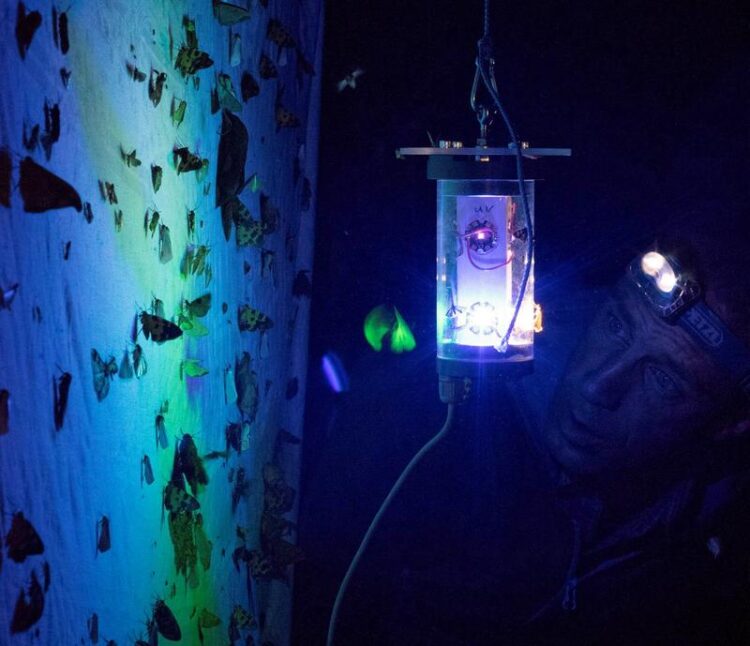Fatal attraction

Vor allem kurzwelliges blaues Licht zieht nachtaktive Insekten an.
Gunnar Brehm/Universität Jena
Biologists from the University of Jena publish study on the relationship between flying insects and light pollution
Jena, the “city of light”, has its dark sides. If you look up at the night sky from the city centre, you can only make out the brightest stars. Lighting in the streets and shop windows is too bright, obscuring the view of the night sky. However, the consequences of this “light pollution” are much more devastating for nocturnal insects. Attracted by the light, they can no longer find mates, lay eggs or pollinate plants.
“Light pollution probably plays a significant role in insect mortality,” says Dr Gunnar Brehm of Friedrich Schiller University Jena. The biologist and his team have recently published a new study in the journal “Insect Conservation and Diversity” on how strongly insects are attracted to light.
The shortest wavelength is most attractive to insects
The scientists installed an extensive experimental setup in the old lecture hall of Jena’s Children’s Hospital. In this setup, different light sources were offered to 6,116 moths from 95 species. Most of the species were native, supplemented by some from other areas. It was then meticulously recorded which insect flew towards which light. Almost all species headed for the light sources, according to one of the results, with the males being somewhat more active.
“Our study clearly shows that in each case the shortest wavelength attracted far more insects than green or red light, for example,” says Gunnar Brehm. The effect on moths is problematic because at least 90 percent of the Lepidoptera (butterflies and moths) are nocturnal. When exposed to high levels of light pollution, they are no longer able to pollinate, which causes major ecological – and presumably also economic – damage. Fewer insects also mean fewer birds and bats, which leads to increased losses of species.
It is not only that light pollution is increasing worldwide by two per cent annually. The properties of the light used have also undergone drastic changes. Many municipalities have converted their street lighting to LEDs and the new light has a much higher proportion of short-wave blue radiation. Old fluorescent lights and metal halide lights, which can contain UV radiation, are also especially problematic, says Brehm.
The results also showed that blue light strongly attracts insects. This means that the orange sodium vapour lamps used in the past were far more insect-friendly than modern LED lamps. Warm white LEDs with colour temperatures below 3000 K are therefore probably the most sensible alternative at present, says Brehm. “Orange or red light would actually be ideal.” Wherever possible, light should be used in a targeted fashion, sparingly, with long wavelengths and limited in time. That would allow us to see the Milky Way again in residential areas.
Wissenschaftliche Ansprechpartner:
Dr Gunnar Brehm
Institute of Zoology and Evolutionary Biology of Friedrich Schiller University Jena
Erbertstraße 1, 07743 Jena, Germany
Tel.: +49 (0)3641 / 949184
E-mail: gunnar.brehm(at)uni-jena.de
Originalpublikation:
Brehm et al: Moths are strongly attracted to ultraviolet and blue radiation DOI: 10.1111/icad.12476
Weitere Informationen:
Media Contact
All latest news from the category: Life Sciences and Chemistry
Articles and reports from the Life Sciences and chemistry area deal with applied and basic research into modern biology, chemistry and human medicine.
Valuable information can be found on a range of life sciences fields including bacteriology, biochemistry, bionics, bioinformatics, biophysics, biotechnology, genetics, geobotany, human biology, marine biology, microbiology, molecular biology, cellular biology, zoology, bioinorganic chemistry, microchemistry and environmental chemistry.
Newest articles

You are What You Eat—Stanford Study Links Fiber to Anti-Cancer Gene Modulation
The Fiber Gap: A Growing Concern in American Diets Fiber is well known to be an important part of a healthy diet, yet less than 10% of Americans eat the minimum recommended…

Trust Your Gut—RNA-Protein Discovery for Better Immunity
HIRI researchers uncover control mechanisms of polysaccharide utilization in Bacteroides thetaiotaomicron. Researchers at the Helmholtz Institute for RNA-based Infection Research (HIRI) and the Julius-Maximilians-Universität (JMU) in Würzburg have identified a…

ASXL1 Mutation: The Hidden Trigger Behind Blood Cancers and Inflammation
Scientists show how a mutated gene harms red and white blood cells. LA JOLLA, CA—Scientists at La Jolla Institute for Immunology (LJI) have discovered how a mutated gene kicks off…



